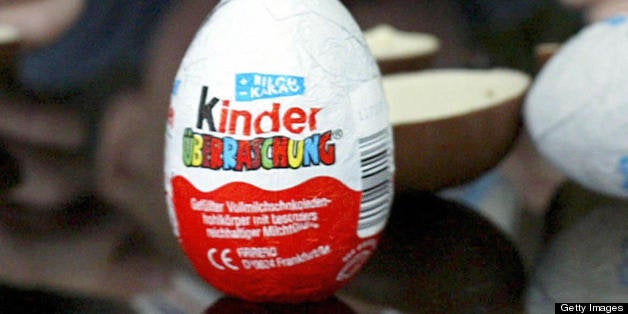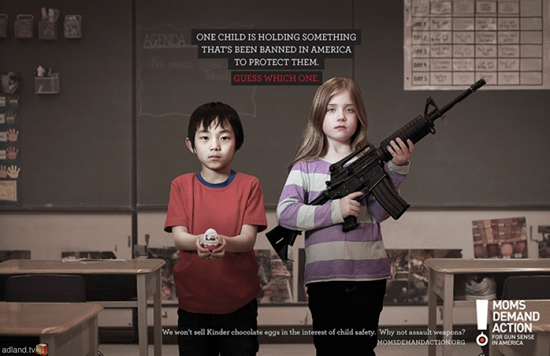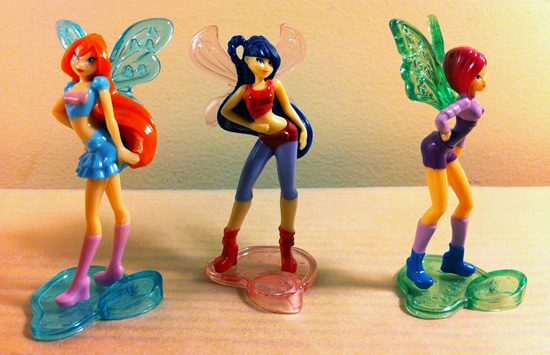
If you're American, you may not be familiar with Kinder Surprise eggs, an Italian candy product that is not sold in the U.S. because of a 1938 law prohibiting putting non-edible things inside of food.
Or maybe you recently discovered these eggs through the powerful and viral anti-gun campaign run by Moms Demand Action:
Kinder Surprise eggs target the 5-10 age range, I'm guessing, based on the kinds of toys that are in them. I grew up with toys in cereal boxes and Cracker Jacks. It's part of being a kid! My little brother and I would choose our breakfast cereal based on what the "free-inside" was. One day, when I was 7, I was sure I'd seen a fairy disappear into my room's heating vent just as I woke up. And, that morning, I got two free-insides in my cereal! I knew it was the fairy's doing...
Now I live in France, where you can always find Kinder Surprise eggs just before the register at the grocery store, in the impulse-buy zone, and just where you're likely to wish for something to placate your antsy little kid for a bit while you wait in line. That's where I was when I saw the pink boxes covered with pictures of tiny fairies from Winx Club, an Italian cartoon series I'd never heard of. They looked cute, and I grabbed one. On impulse. As promised by the name, I was surprised. Once I got home and saw the fairy up close, I knew that if I'd had a little girl at home, there is no way on earth I would have bought one. Even if she'd pitched a tantrum on this scale in the store.
There is something very, very wrong with this picture. I probably don't even have to say what it is. But I will, just in case you've been on another planet. They're too skinny, their proportions are unnatural and they're way too sexy. And no normal girl can bend her back or her hips like that. These poor fairies have severe scoliosis or something. It looks painful.
There's a sickening trend towards sexualization of girls in toys and entertainment. And there's a long-term issue, going back to Barbie's youth, with presenting girls with unhealthy and unrealistic physical ideals through toys and entertainment intended for them. This April 2013 article in The Atlantic sums up these issues nicely. And, since this article appeared, there has been yet another controversy surrounding the addition of Merida, the girl heroine of Disney's Brave, to the Disney princess line-up. After cinching in her waist, slapping some make-up on her face, lowering her neckline, and more, of course. Because the destiny of all spunky young women is to grow up to be decorative princesses.
(Of course, every male action figure that a boy sees in his life looks like someone's ideal of male physical perfection, and there's no doubt this takes its toll on little boys too. Not to mention that action figures are almost always associated with violence. So for boys, there's an unrealistic physical expectation and an expectation/endorsement of violence inherent in their toys... People don't talk nearly enough about this issue, if you ask me. I raised a son.)
I asked the 19-year-old daughter of a friend what her impressions were of these fairies. This young woman, a mechanical engineering student at Boston University, could be the model for the fairy in the blue skirt (but with realistic proportions, no scoliosis and more class). Her first response, like mine, was "Cute!" Then I pointed out that they were for very young girls, and told her I was planning to write about the sexualization of girls' toys. She mentioned the Atlantic article I link to above, and told me how things had changed since she was small. (Oh-so-long ago.)
For example, she said that when she was very young, her dance class performed "Puff the Magic Dragon," and the little girls were dressed in "puffy little" dragon suits. She tells me little girls performing it now are dressed in frilly green skirts and v-necked leotards. In her opinion, the "Toddlers and Tiaras" phenomenon may be partly responsible. She says that her dance clothes in general consisted of unitards and simple skirts, but that the clothes girls are wearing now look like ice-skating costumes.
My friend's daughter, whom I've known since she was two months old, was visiting me here in Paris because she's spending a semester in Germany and she had a long weekend. I took advantage of her presence to ask her to try to pose like the fairies. Try as she might, lean and limber as she is, she couldn't twist her body into any of these positions. Gee. Makes you think. Or at least it should.
So, what can we do about the exploitation of children by the greedy makers of toys and kids' entertainment? Amy Jussel, of Shaping Youth suggests,
We need to start asking bigger, tougher, hardball questions; look deeper into the effects of playing with thin dolls on body image and food intake in young girls for example, or the increase of sexual assault, dating violence and "rape culture" with social norming of misogynistic media, hyper masculine toys and monstrous marketing messages.
All that and, of course, just don't buy it.

